Research Achievement
2017
손지기(chirality, 카이랄성)는 수학, 화학, 물리학, 생물학 등 다양한 과학 분야에서 비대칭성을 가리키는 용어이며, 손을 뜻하는 그리스어에서 유래하였다. 왼손과 오른손이 서로 겹칠 수 없는 거울상 대칭이기 때문이다. 이런 손지기는 일상생활뿐만 아니라, 다양한 연구 분야에서 흥미로운 현상으로 나타난다. 특히 응집물질물리 분야에서 이런 손지기가 위상학적 들뜸(topological excitation)의 한 형태이며 위상학적으로 보호되어 있기 때문에 외부 간섭에도 쉽게 변하지 않아 차세대 정보 전달 매체로 응용할 수 있다는 가능성이 보고되었다.
본 연구단은 2015년 폭 1nm의 부도체 나노 인듐원자선에서 손지기 솔리톤(chiral soliton, Fig. 1a-c 참조)의 존재를 세계 최초로 규명한데 이어, 후속 연구를 통해 그 손지기 솔리톤 사이의 변환을 관찰함으로써 위상학적 들뜸을 이용한 정보전달매체로서의 가능성을 세계 최초로 밝혔다(2017년).
이번 연구에서 인듐 일차원 원자선에서 존재하는 손지기 솔리톤의 서로 다른 위상 상태를 바꿀 수 있는 방법을 찾았다. 그 방법은 다른 종류의 손지기 솔리톤을 이용한 것이다. 이런 손지기 솔리톤의 위상 상태가 위상 전하(topological charge)와 대응되기 때문에 이번 연구를 바탕으로 위상 전하의 산술적인 연산(algebraic operation)도 가능함을 밝혔다.
결과적으로 외부 간섭으로부터 영향을 거의 받지 않는 솔리톤으로, 안전하게 위상 전하를 전달하고 또한 산술 연산도 가능하여 앞으로 관련 연구에 새로운 방향을 제시하였다는데 큰 의미가 있다.
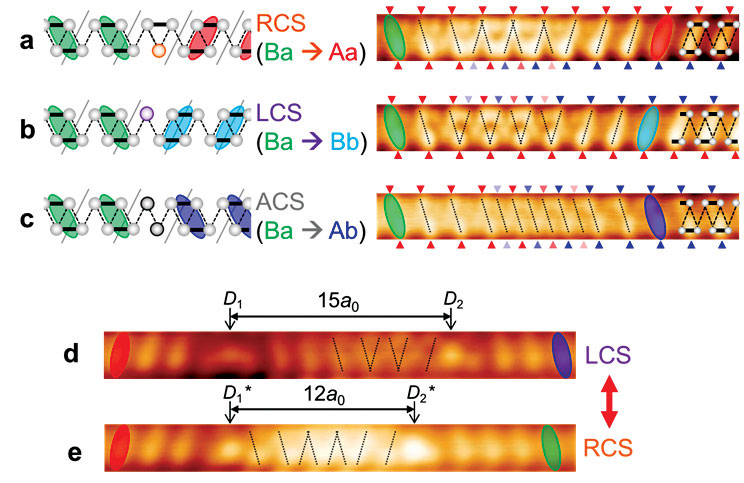
Figure 1. a-c, schematics (left) and scanning tunneling microscopy images (right) of chiral solitons. d, e, switching between chiral solitons trapped by two defects.
Chirality is a scientific term representing a property of asymmetry in several fields of science including mathematics, biology, chemistry, and physics. The word is derived from Greek χειρ, which means a ‘hand’; because no matter how the two hands are oriented, it is impossible for all the major features of both hands to coincide across all axes. Such chirality emerges as very interesting phenomena in various research fields. In condensed matter physics, some topological excitations appear as chirality. Since they are topologically protected, they can be used as future information carriers without being perturbed against external noise.
In 2015, we first proved the existence of chiral solitons (Fig. 1 a-c) experimentally and theorectically. Through the following research, we finally discovered the switching between chiral solitons in 2017. This result gives us a new opportunity to use chiral solitons as information carriers.
The main result of our study is to find an experimental method for switching topological states or chirality of chiral solitons. The method is using other chiral soltions for switching. Since each chirality of solitons corresponds to each topological charge, we can do algebraic operation with topological charges in principle.
In this study, we proposed a novel approach to send and manipulate topological charges with robust chiral solitons, which possibly leads to a future electronics called solitonics.
고체의 특이한 위상학적인 구조에 의해 일어나는 비상식적인 전도현상은 최근 응집물리분야의 핵심적이고 도전적인 주제중의 하나이다. 특히 최근 활발히 연구되고 있는 위상 준금속의 경우, 다양한 종류의 위상특이점에 의한 베리곡면이 역격자 공간에 존재하게 되고, 전도전자가 베리곡면을 따라 움직일 때는 가상의 자기장을 느끼게 되기 때문에 결과적으로 특이한 운동 양상을 띠게 된다. 예를 들어 와일 금속의 경우 위상학적 특이점이 역격자 공간에서 짝으로 존재하는데, 이러한 와일 점을 하나를 감싸는 페르미 면에 대해서는 전류보존법칙이 더 이상 유지되지 못하게 되고, 대신 두 개의 와일점을 동시에 고려해야만 전류보존이 가능해진다. 이는 역격자 공간에서 짝을 이루는 두 개의 와일점을 따라서 손실이 전혀 없는 전도 통로가 존재한다는 것을 의미한다.
즉, 두 개의 와일점과 나란한 방향으로는 전자의 흐름이 매우 용이하게 되고, 음의 자기저항과 같은 비정상적인 전도현상이 발현된다. 이처럼 카이랄 전도에 의한 전자의 거동은 기존의 드루드나 란다우 모델로는 이해할 수 없기 때문에, 위상학적인 전도현상에 대한 새로운 이해가 필요한 상황이다.
본 연구에서는 와일 금속의 경우, 위상학적인 구조에 의한 카이랄 전도효과 및 전하 펌핑 현상으로 옴의 법칙이 더 이상 만족하지 않는다는 것을 밝혀내었다. 연구에 사용된 Bi0.96Sb0.04단결정의 경우, 자기장을 인가하였을 때 자기장 방향으로 두 개의 와일 점이 생성되는데, 전류의 방향이 두 개의 와일점과 나란하게 되었을 경우에만 비선형적인 전류-전압 특성을 보이는 것이 관측 되었다. 이는 손실 없는 전류통로가 비선형적 전류생성에 직접적인 원인이라는 것을 의미한다. 이러한 실험적인 결과는 위상전도특성에 따른 전하펌핑 효과를 고려한 볼츠만 전도이론을 통해 잘 설명될 수 있으며, 동일한 원인으로 발현되는 음의 자기저항과도 잘 맞는다는 것을 알 수 있다. 본 연구에서 발견한 비선형적인 전도특성은 와일 준금속을 특징짓는 고유특성임과 동시에 이를 이용한 새로운 비선형 전자소자나 광학소자 개발 및 란다우 페르미 이론을 넘어서는 새로운 위상전도 이론 발전 등으로 나아가는 시발점이 될 것으로 기대된다.
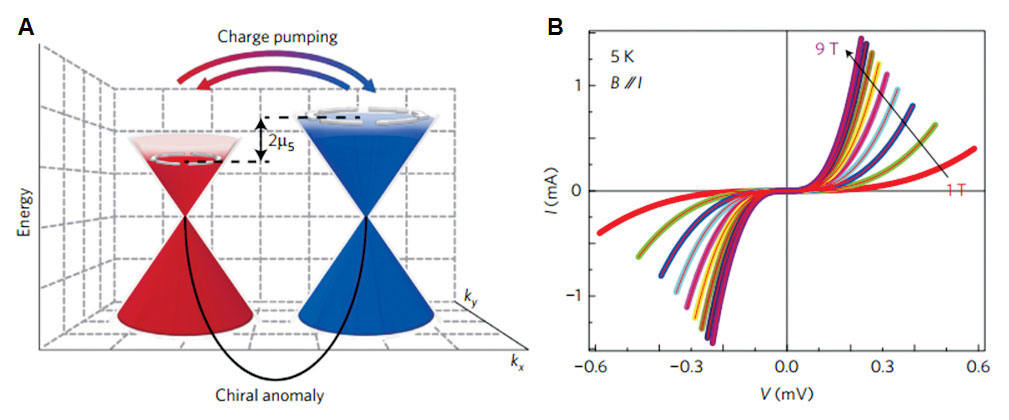
Figure 2. Nonlinear I-V characteristic of the topological semimetal phase of Bi0.96Sb0.04.
The role of a topological structure on anomalous transport phenomena is currently one of the challenging questions.
Particularly in topological semimetals possessing various types of point or line nodes singularities in the momentum space, the resulting Berry curvatures produce a fictitious magnetic field and significantly affect electron’s motion. While the chiral anomaly was observed as a negative longitudinal magnetoresistivity, its consequence in electronic transport has been unclear. So far, all existing discussions have been limited to the linear response regime, governed by Ohm’s law. We found, however, that in a Weyl metal, Ohm’s law breaks down due to a topological structure of the chiral anomaly with the charge pumping effect. We take Bi0.96Sb0.04 single crystal as a model 3D Dirac semimetal, which becomes a Weyl semimetal under magnetic field. The nonlinear I–V characteristics in the diffusive limit occurs only for a magnetic-field aligned to an electric field, in which dissipation-less conduction channel connecting two paired Weyl points contributes to the electrical transport. The Boltzmann transport theory with the charge pumping effect reveals the topological nonlinear conductivity, and it leads to a universal scaling function of the longitudinal magnetoconductivity, which completely describes our experimental observations. As a hallmark of Weyl metals, the nonlinear conductivity provides a venue for nonlinear electronics, optical applications, and the development of a topological Fermi-liquid theory beyond the Landau Fermi-liquid theory. This work thus puts an important stepstone in understanding the physical consequence of topology in a new class of topological materials.
본 연구에서는 금속성과 반도체성을 보이는 다형상 MoTe2 물질의 선택적 합성에 성공하고, 이를 연속적인 에피 성장을 통해 원자층에 반도체-금속 접합 전자 소자를 구현하였다. 이러한 새로운 1차원 접합은 그동안 2차원 물질 연구에서 난제로 파악되는 고 접합 저항 문제를 해결하였고, 특히 20 meV 정도의 극소 저항 접합을 갖는 2차원 전자 소자를 구현하였다. 제시된 연구는 원자층 수준에서의 합성을 통하여 동일한 물질에서 반도체와 금속 성질을 선택적으로 갖도록 하는 조작이 가능함을 예시할 뿐 아니라, 이러한 연속 합성법을 통해 집적 전자 소자의 구현, 즉 물질 조작에 의한 “synthetic electronics”가 가능함을 보여주는데 그 의미가 있다.
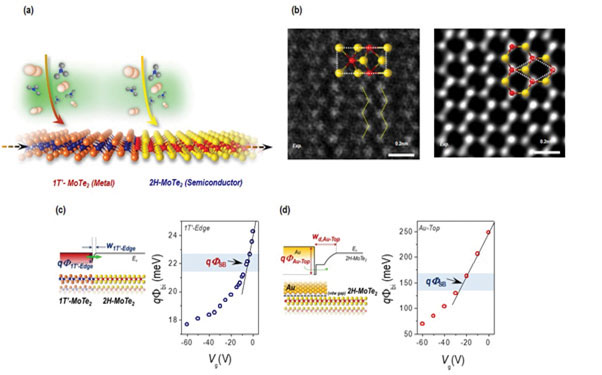
We report on the polymorphic integration of distinct metallic (1T′) and semiconducting (2H) MoTe2 crystals within the same atomic planes by heteroepitaxy. Crystal polymorphism selectively stabilizes the electronic phase of atomically thin transition-metal dichalcogenides (TMDCs) as metallic or semiconducting, suggesting the potential to integrate these polymorphs as circuit components in two-dimensional electronic circuitry. Developing a selective and sequential growth strategy for such two-dimensional polymorphs in the vapour phase is a critical step in this endeavour. The realized polymorphic coplanar contact is atomically coherent, and its barrier potential is spatially tight-confined over a length of only a few nanometres, with a lowest contact barrier height of ∼25meV. This direct formation of electronic device with sequential synthetic suggest the pathway of synthetic electronics.
We report on the polymorphic integration of distinct metallic (1T′) and semiconducting (2H) MoTe2 crystals within the same atomic planes by heteroepitaxy. Crystal polymorphism selectively stabilizes the electronic phase of atomically thin transition-metal dichalcogenides (TMDCs) as metallic or semiconducting, suggesting the potential to integrate these polymorphs as circuit components in two-dimensional electronic circuitry. Developing a selective and sequential growth strategy for such two-dimensional polymorphs in the vapour phase is a critical step in this endeavour. The realized polymorphic coplanar contact is atomically coherent, and its barrier potential is spatially tight-confined over a length of only a few nanometres, with a lowest contact barrier height of ∼25meV. This direct formation of electronic device with sequential synthetic suggest the pathway of synthetic electronics.
본 연구진은 지난 4년간 전자들의 상호작용이 강한 층상물질을 새로운 이종접합계면을 창출하기 위한 기판으로서 연구해왔다. 그 중 가장 주목하고 있는 물질계는 1T-TaS2로서 이 물질은 2차원 전자계의 특성인 전하밀도파와 더불어 강한 상호작용에 의한 Mott 절연체상이 됨이 알려져 있다. 특히 이 물질의 경우는 강한 압력과 극저온 상태에서 Mott 절연체로부터 초전도현상이 발현하면서 전하밀도파가 억제되는 현상을 보이나 그 상관 관계는 아직 규명되지 않았다. 이러한 초전도성의 발현에는 전하밀도의 질서를 파괴하는 domain wall이 중요한 역할을 한다고 알려져 왔으나, 이 domain wall의 특성이나 구조에 대해서는 밝혀진 바가 없었다. 본 연구에서는 세계최초로 1T-TaS2 CDW 상의 domain wall의 원자구조와 전자구조를 밝혔다. 특히 domain wall에 국소적으로 존재하는 Mott gap 내부의 in-gap 전자구조를 세계최초로 확인하였으며, 전자구조계산을 통하여 이러한 in-gap state의 특성이 전자들의 강한 상호작용을 고려하지 않으면 기술될 수 없음을 보였다. 특히 지금까지 오랫동안 믿어져왔던 domain wall in-gap state가 금속적이라는 통설을 부정하였다. 이러한 비금속적인 in-gap state는 domain wall 내부의 원자구조의 변형과 전자상호작용에 의하여 발생한다. 이 결과는 오랫동안 여러 가지 물성을 설명하기 위해 사용되어온 금속적인 in-gap state의 가설을 뒤집음과 동시에 domain wall 내부 전자들의 강한 상호작용이라는 새로운 개념을 제시하고 있어, 향후 1T-TaS2의 연구 뿐만 아니라 domain wall의 역할이 중요한 다양한 고체물질의 전자물성연구에 중요한 지표가 될 것이다.
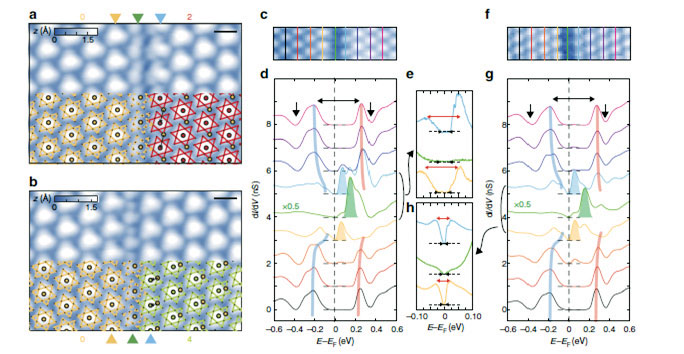
Figure 4. Atomic and electronic structure of domain walls of 1T-TaS2. Spatially resolved dI/dV spectra shows the evolution of the incoherent peaks displayed by the semitransparent blue and red curves.
1T-TaS2 is a strongly correlated two-dimensional material showing charge density waves and Mott transition depending on the temperature. Especially, under a high pressure and low temperature, it becomes superconductor with suppressed charge density wave. Domain wall structures of charge density wave is expected to do an important role in understanding this phenomena and we revealed atomic and electronic structures of the domain wall by scanning tunneling microscopy studies.
Along the domain walls, localized in-gap states of Mott insulator phase was observed and the strong correlation is indispensable for the existence of those states. Atomic distortion and electron interaction is the origin of the domain wall formation and especially, in-gap states are not metallic contrary to the common belief. Interactions between electrons in the domain wall will be an important concept in the understanding of 1T-TaS2 and also of numerous materials with domain wall structures.
전도 전자가 자성에 직접 관여하는 자성 금속의 경우, 종종 자성 상호작용간의 경쟁으로 인해 다양한 기저상태가 나타날 수 있다. 특히, 구리산화물이나 철계 초전도체와 같이 스핀, 전하, 오비탈의 자유도가 매우 복잡하게 관여된 물질계은 기저 상태가 외부요인에 민감하기 때문에 계면 효과에 의해 매우 풍부한 상그림을 만들고, 기존의 물질에서 발현되지 않은 새로운 기저상태를 만들기도 한다. 본 연구에서는 상호작용인 충분한 전도전자와 국소스핀이 공존하는 철계초전도체 중에 하나인 Sr2VO3FeAs에서, 초전도층과 모트-절연층간의 계면효과에 의해 기존 물질에서 보고되지 않은 특이한 기저상태를 가지는 것을 최초로 보고 하였다. Sr2VO3FeAs에서 관측된 상전이는 자기 정렬없이 사각격자구조를 유지하는 상전이로 시간역전과 C4 회전 대칭이 깨지지 않은, 전형적인 숨겨진 정렬 (hidden order) 상태이다. 이번 발견을 통해 철계초전도체와 같이 강상관 전도전자계가 또다른 강상관 국소전자계와 적층되었을 때, 이들 간의 계면 상호작용의 결과로 그 기저상태가 매우 다양하게 변화할 수 있음이 실험적으로 확인되었다. 이는 향후 다양한 강상관 이종접합계의 양자물성연구로 발전될 것으로 기대된다.
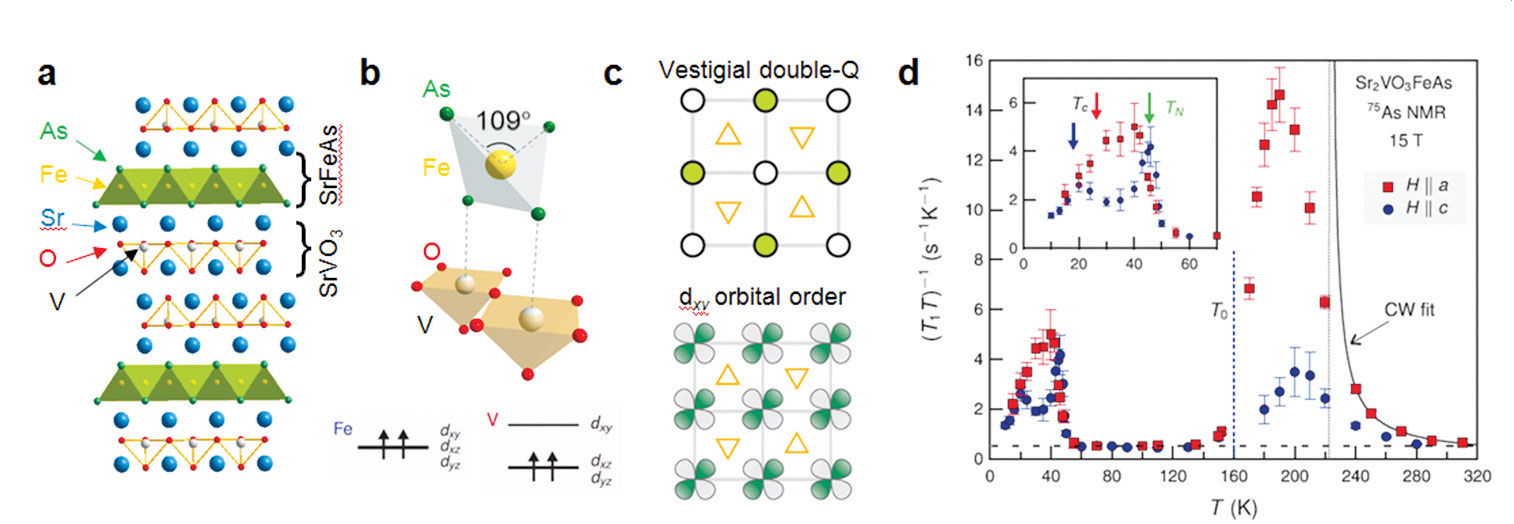
Figure 5. Illustration of a correlated heterostructure of an iron-based superconductor (SrFeAs) and a Mott insulator (SrVO3) (b) Local crystal and electronic structures of a FeAs4 tetraheron and a VO5 piramide. (c) Possible C4-symmetric charge/orbital orders in the FeAs layers. (d) The spin-lattice relaxation time as a function of temperature, revealing C4-symmetric orders.
In the spin systems such as metallic magnets with itinerant electrons forming magnetic moments, various types of Fermi surface instabilities are often frustrated, which stabilizes complex magnetic phases with broken time-reversal or lattice symmetries or even hidden phases without breaking any of them. Particularly, in strongly correlated electron materials, including cuprates and iron-based superconductors(FeSCs), the balance between competing interactions are extremely sensitive to external perturbations. Therefore, when the proximity-coupled layer is strongly correlated and magnetically active, additional interfacial spin interaction may induce distinct ground states in FeSCs, which however has not been explored so far. In order to create new types of quantum matter in atomic scale heterostructures, we take a heterostructured FeSCs, Sr2VO3FeAs, as a model system, consisting of a superconducting iron pnictide layer and a Mott-insulating vanadium oxide layer. Each constituent layers usually host distinct magnetic orders, the stripe antiferromagnetic/nematic order in iron pnictide layer and the Néel antiferromagnetic order in vanadium oxide layer. We find however that an unusual charge/orbital order, without either static magnetism or broken C4-symmetry. Such an unprecedented “hidden” order is due to frustration of the otherwise dominant iron stripe and vanadium Néel luctuations via interfacial magnetic proximity coupling. Our findings therefore manifest that the physics of itinerant correlated system can become even richer in the proximity of other correlated systems and also offer a new avenue for exploring unusual ground state in the correlated heterostructures.
본 연구단에서 개발 중인 스핀 및 각도분해 광전자분광 장비는 고체 내의 에너지 밴드 구조를 에너지와 운동량에 따라 측정할 수 있는 장치로, 특히 감도가 뛰어난 교환산란 방식의 스핀 검출기를 장착하여 밴드별 스핀상태의 측정도 동시에 가능하도록 설계되었다. 별도의 장소에서 셋업을 완료한 이 장비는 2017년 초반까지 포항가속기의 4A2 빔라인으로의 이전, 설치를 완료하였다. 그 후 수개월 간의 정렬 및 커미셔닝 작업을 통해 통해 실제 방사광을 이용한 각도분해 광전자 분광 실험이 가능하게 되었다. 또한 하반기부터는 연구단 내부뿐만 아니라, 외부의 이용자들에게도 이를 공개하여 수차례의 외부 실험에도 사용되었다. 그림 6은 이 장비를 통해 얻어진 graphene 및 양자물질들에 대한 실제 밴드 구조 측정결과이다. 교환 상호작용 방식의 스핀 검출기 또한 대부분의 부품 설치를 완료하였으며, 2018년 초반에는 그 성능을 테스트하고 최적화하는 작업을 시작할 예정이다.
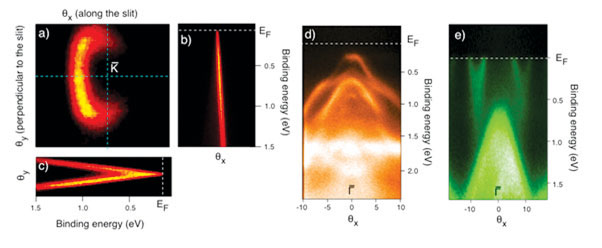
Figure 6. Selected test data from the Spin ARPES (a)(b)(c) Band structure of graphene taken with the deflection mode of DA-30 analyzer (d)(e) Band structure of Ta2NiSe5 & NbS2.
The installation of spin and angle-resolved photoelectron spectroscopy (Spin ARPES) end-station at the 4A2 beamline of Pohang Accelerator Laboratory (PAL) was completed. The system makes it enable to directly investigate the electronic structures of various materials by detecting the energy, momentum, and spin of individual electrons within them. In particular, the state-of-the-art electron analyzer simultaneously reveals the three dimensional space of energy and momenta in two direction, and the VLEED-type spin detector enhances the spin detection efficiency by orders of magnitudes compared to the conventional Mott-type spin detector. In early 2017, the entire system was moved to the beamline port and the commissioning with the real synchrotron radiation was done by summer. After that, it was opened to the inside researchers and outside users as well. A few experiments have done by them and selected spectra are shown in figure 6. Left panel shows the band mapping results of graphene and right panel shows band structures taken for Ta2NiSe5 & NbS2. They show well that the construction of a high-performance ARPES system was completed. Also, most of parts of spin detector were delivered and installed at the system. Evaporator, Helmholtz coils, and transfer system for the spin detector have been tested and characterized in 2017. The detector will be tested and optimized before summer in the first half of 2018.
2017년 5월, 본 연구단의 극저온 고자기장 주사 터널 현미경을 위한 초전도 자석을 장착한 희석식 냉동기의 조립을 마치고, 그 시험 운용을 성공적으로 수행하였다(그림 7). 냉동기 운용 조건을 최적화하여 냉동기 콜드 팁의 최저온도는 5.9 mK 까지 내려감을 확인하였고, 100 mK에서 600 μW의 강력한 냉각파워를 확인하였다. 제작사에서 테스트 할 때 문제가 되었던 벡터형 초전도 자석의 성능도, 문제 해결 뒤에는 최대 자기장(9+2+2 테슬라)이 안정적으로 가동됨을 확인하였다.
샘플 내의 전자온도를 최대한 낮추기 위해, 현미경 헤드의 크기를 최대한으로 줄이는 노력을 하였다. Koala 드라이브 형태의 z 모터를 자체 개발하여 사용하려 한다(그림 8). 이 극저온 냉동기에 장착될 주사터널 현미경의 헤드와 이의 운용을 위한 10 K 소형 액체 헬륨 냉동기, STM 헤드 매니퓰레이터, 그리고 x, y, z 트랜슬레이터의 디자인을 끝내서 부품 제작에 착수하였다.
-
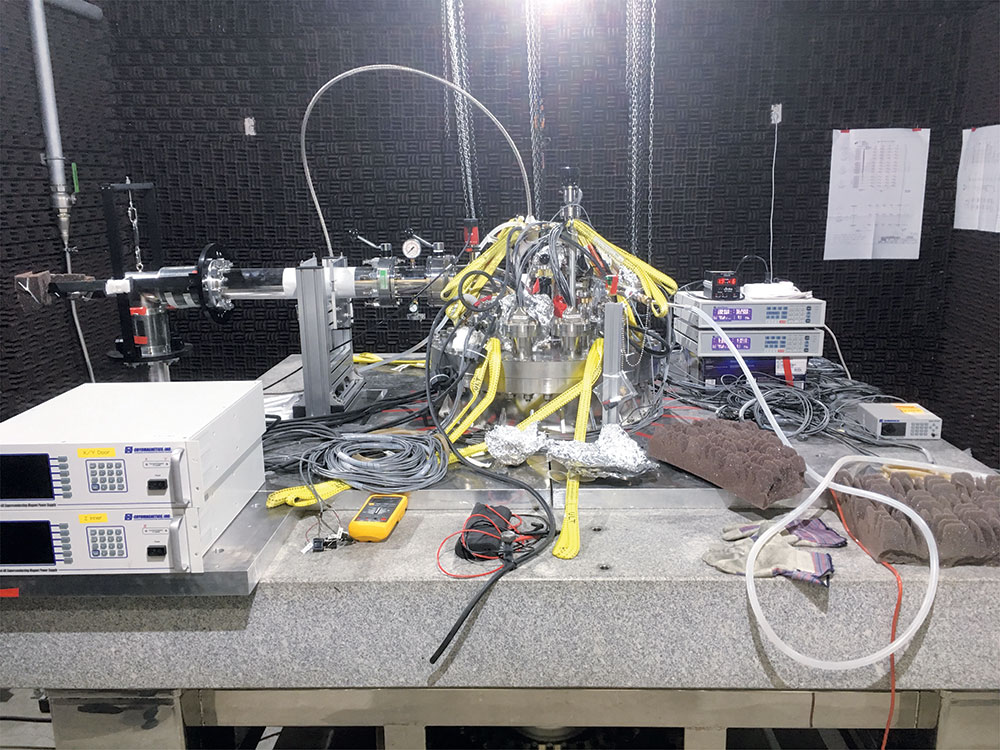
Figure 7. Upper view of our dilution refrigerator.
-
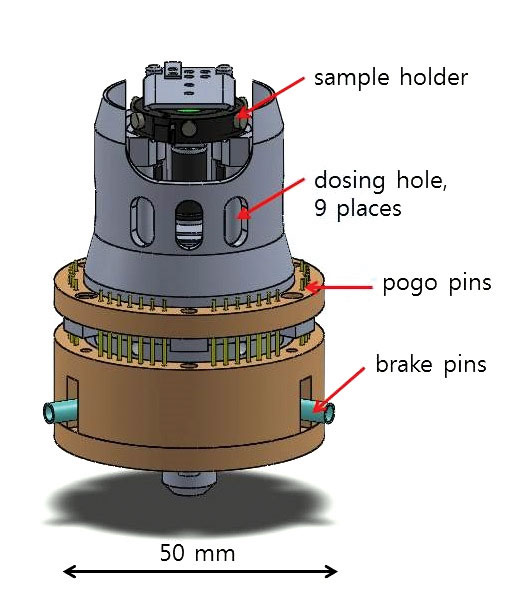
Figure 8. schematic of the scanning tunneling microscope head.
In May 2017, our dilution refrigerator with a superconducting magnet was assembled and tested successfully in the laboratory(Figure 7). By optimizing the operation variables for the cryostat, we confirmed that the base temperature is 5.9 mK, and the cooling power at 100 mK is more than ~ 600 μW. We confirmed that the superconducting magnet, which had a problem in the manufactor site last year, work well up to the maximum magnetic field strength(9 + 2 + 2 Telas).
In order to reach manimum elextron temperature in the sample, we try to minimize the size of our scanner. We designed and constructed adated Koala drive STM z motors(Figure 8). The design of a small-sized ~ 10 K liquid helium cryostat, STM head manipulator, and x, y, z translation stages have been completed, and now various parts for those components are being fabricated.
활용 중인 전기전도도 측정용 가변온도 주사터널현미경은 전기전도도 측정과 원자 분해능 주사터널현미경 측정이 동시에 가능하다. 반면 상대적으로 큰 주사터널현미경 헤드라서, 주어진 냉동기로 온도를 충분히 떨어뜨리기가 어렵다. 현재 액체 헬륨(끓는점 4.2 K)을 이용하여 도달 가능한 최저 온도는 13 K으로, 그 온도보다 더 낮은 온도의 상전이 현상을 관찰할 수 없다.
이런 문제점을 보안하고자, 주사터널현미경 헤드를 구조를 최소화하였다. 그 결과 줄어든 무게(Fig. 9)로 기존 냉동기 성능을 최대로 활용할 수 있어, 냉매의 끓는점에 가까운 샘플/탐침의 온도를 구현하고자 소형 가변온도 주사터널현미경을 구축 중에 있다.
소형화의 핵심은 여섯 개의 피에조 스택으로 이루어진 탐침 이동 장치를 작은 피에조 튜브 2개로 교체한 것이다(Fig. 10 왼쪽). 이와 더불어 주사터널현미경 헤드 본체의 크기를 줄이고 꼭 필요한 기능만을 살려 무게를 최소화하였다(Fig. 10 가운데). 마지막으로 기존 알루미늄 열 차단 쉴드를 열전도도가 더 좋은 구리로 제작하여 냉동기를 통한 냉각이 원활하게 되도록 하였다(Fig. 10 오른쪽).
현재 최종 조립이 이루어지고 있어 1-2개월 내로 성능 테스트를 할 수 있을 것이라 전망한다. 본 장비가 구축 완료된 뒤에는 그래핀 및 2차원 물질의 온도에 따른 상전이 현상을 연구하는데 활용하고자 한다.
-
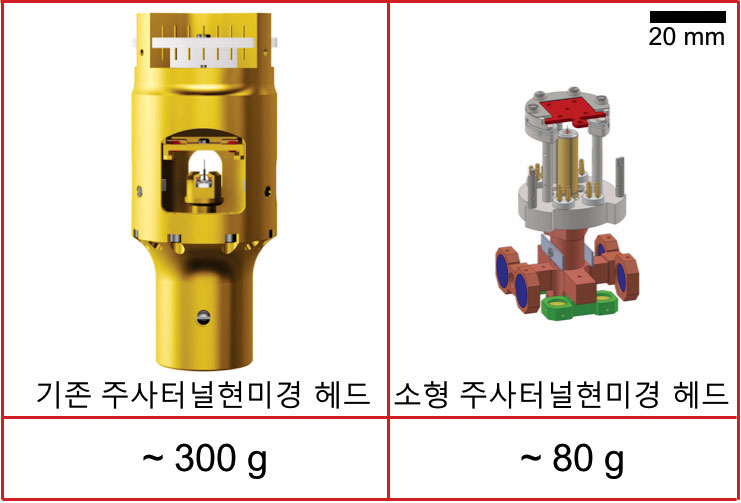
Figure 9. Size comparison between existing and newly designed STM heads.
-
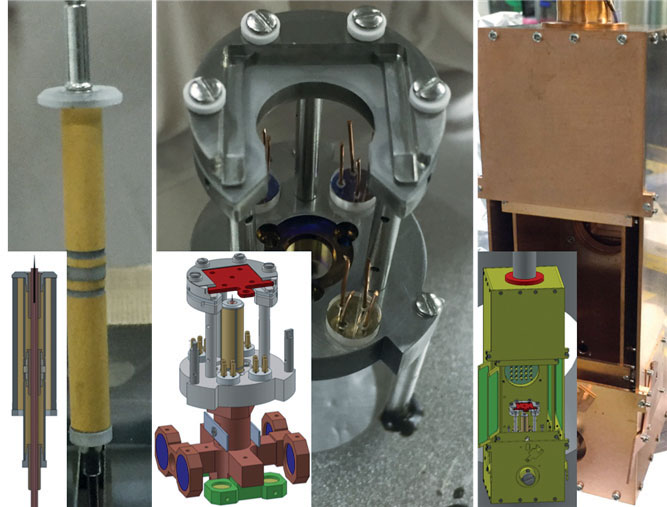
Figure 10. (left) tip coarse motion device, (middle) STM head, (right) thermal shields surrounding STM head.
We can perform scanning tunneling microscopy and transport measurements simultaneously with our variable scanning tunneling microscope (VTSTM) with transport capability. However, it has a drawback due to large STM head for multifunctionality. With liquid helium (boiling temperature: 4.2 K), we can cool the VTSTM head down to only 13 K, so we can’t observe any phase transition below 13 K.
In order to overcome this limitation, we redesigned a much smaller STM head for lower working temperature. We estimated the base temperature would be very close to the boiling temperature of liquid cryogen thanks to the lower weight (Fig. 9).
The key of miniaturization is to replace six feet of piezo stacks with tiny piezo tubes (Fig. 10 left). As well, we fully redesigned the STM head with only functionalities required to STM operation (Fig. 10 middle). Lastly, we used thermal shield made of copper instead of aluminium for better thermal conductivity (Fig. 10 right).
Currently, we are assembling the STM head for test run. Once it is installed, we will use it to study temperature-induced phase transitions of graphene as well as 2D materials.
 Center for Artificial Low
Center for Artificial Low